

 |
My Trip to Rheims |
 |
Return to the Paris Trip Page |
One afternoon, I took a train trip out to the suburbs to see the Palace of Versailles. When it was built, the Palace was a distance outside the city, and it took some time to get there, but now, Versailles is just a far suburb of the city itself. There were tours that you could take, but all I wanted to do was wander around by myself. This is one of the main entry gates to the Palace grounds.
Getting to Versailles
|
I got a fairly early start one morning on the 45-minute trip out to the suburb of Versailles, where I walked from the commuter rail station to the entrance to Versailles itself.
I have not ridden very much on European trains; I think this was only my second time. But I am continually impressed with how easy it is to use them for trips that we would usually make by car here in the States. But being as old as it is, Europe's cities are almost all so old that they were essentially the cities we see today before the advent of the automobile. That means that they were built for a population that walked (or in some cases, used carriages). Housing was concentrated and services were spread out through residential areas. So it was no problem to walk from my hotel to a train station, hop a train and, when it arrived in Versailles, get off, leave the station, and have most of the sights in Versailles within walking distance.
Versailles Entry/Orientation
|
Versailles was the seat of political power in the Kingdom of France from 1682, when Louis XIV moved the royal court from Paris, until the royal family was forced to return to the capital in October 1789, within three months after the beginning of the French Revolution. Versailles is therefore famous not only as a building, but as a symbol of the system of absolute monarchy of the Ancien Régime.
On 6 May 1682, Versailles became officially the seat of the government of the kingdom of France, the home of the French king, Louis XIV, and of the location of the royal court. Symbolically, the central room of the long extensive symmetrical range of buildings was the King's Bedchamber, which itself was centered on the lavish and symbolic state bed; the design of the chateau was such that the layout of the entire area radiated from this fulcrum.
|
The palace that we recognize today was largely completed by the death of Louis XIV in 1715. The eastern facing palace has a U-shaped layout, with the symmetrical advancing secondary wings terminating with the Dufour Pavilion on the south, and the Gabriel Pavilion to the north, creating an expansive "cour d'honneur" known as the Royal Court. Flanking the Royal Court are two enormous asymmetrical wings that result in a facade some 1300 feet long encompassing over 700,000 square feet; the palace has 700 rooms, more than 2,000 windows, 1,250 fireplaces and 67 staircases.
The façade of the original lodge is preserved on the entrance front. Built of red brick and cut stone embellishments, the U-shaped layout surrounds a black-and-white marble courtyard. In the center, a 3-storey avant-corps fronted with eight red marble columns supporting a gilded wrought-iron balcony is surmounted with a triangle of lead statuary surrounding a large clock, whose hands were stopped upon the death of Louis XIV. The rest of the façade is completed with columns, painted and gilded wrought-iron balconies and dozens of stone tables decorated with consoles holding marble busts of Roman emperors. Atop the mansard slate roof are elaborate dormer windows and gilt lead roof dressings that were added between 1679 and 1681.
|
At various periods before Louis XIV established absolute rule, France, like the Holy Roman Empire, lacked central authority and was not the unified state it was to become during subsequent centuries. During the Middle Ages, French nobles were often more powerful than the King of France and, although technically loyal to him, they possessed their own provincial seats of power and government, culturally influential courts and armies loyal to them, not to the king, and the right to levy their own taxes on their subjects. Some families were so powerful, they achieved international prominence and contracted marriage alliances with foreign royal houses to further their own political ambitions. Although nominally Kings of France, de facto royal power had at times been limited purely to the region around Paris.
At the entry gates I stopped to take a picture, and then, passing through them and moving closer to the palace itself, I took another:
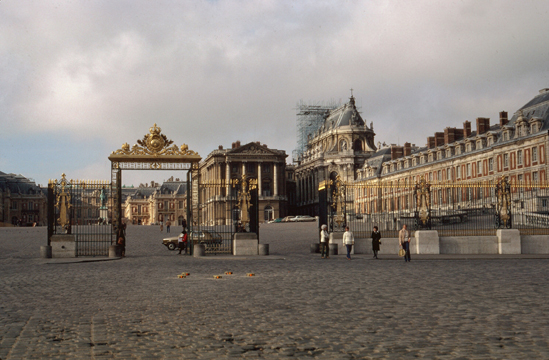 All of the ironwork and gates are a recent addition to the Palace grounds, obviously to control the movement of vehicles in the area. But here, from some distance away, you can get a good idea of the incredible extent of the buildings themselves. |
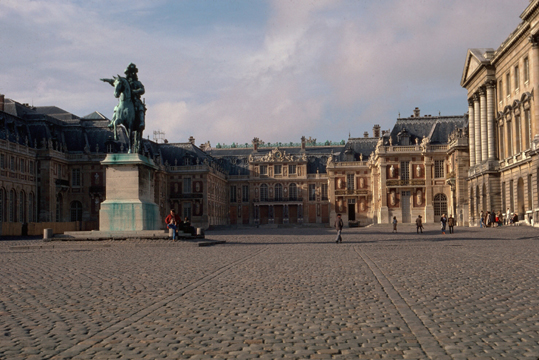 Moving in closer here, you can still marvel at the size and extent of the buildings. The Palace is certainly bigger than most buildings in the world, whether they be public or private. |
I did not have to join a tour to go into the palace itself; there was a route marked that took the visitor through representative rooms from the various royal apartments. Sadly, I did not take notes as to which room I was in when I took every single picture; I really was not trying to document everything. I just photographed what I thought was interesting. Photography was not permitted in every room, and in no case was flash allowed. Whether the prohibition on flash photography is to avoid disturbing the other tourists, or because the flash has some detrimental effect, I do not know.
|
|
The fireplace also gives you a yardstick to judge the size of some of these rooms. You can judge the size of the room by the size of the fireplace, and you can judge the size of the fireplace by comparing its opening to the height of the people entering the room.
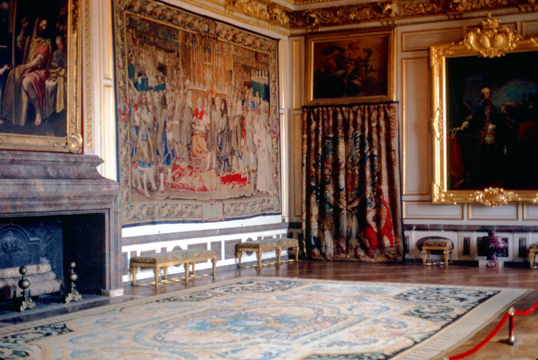 Notice the extent of the artwork and tapestries that are on display throughout the Palace. It seemed as if no room was without its own extensive ornamentation. Ropes that keep the tourists from walking on the carpets antiques themselves. The paintings, tapestries, frescoes, and furniture worth a fortune all by themselves. |
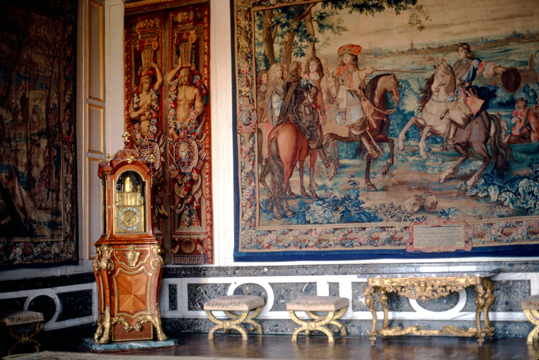 The clock in the corner of this room was given to Louis XIV in 1706. It is the only piece of furniture from the Grand Appartement that has survived (although the original marquetry by the artist has been replaced. As with many of the rooms, tapestries covered all the walls and the floors were deeply polished hardwoods. |
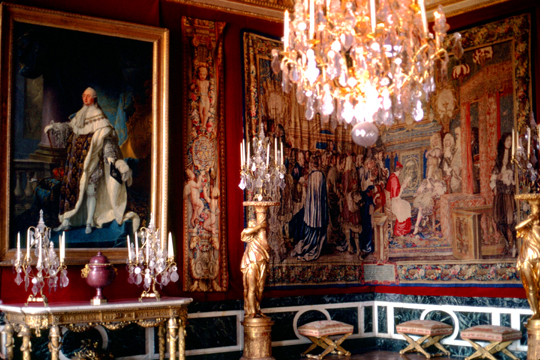 This is one of the small reception rooms, where the King met with visitors. You can believe me when I tell you that there was almost no vacant wall space anywhere in the Palace. |
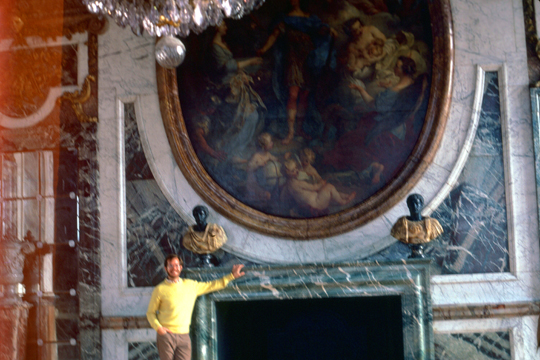 Here I am, standing beside one of the most beautiful fireplaces in the Palace, this one made of green marble. |
Probably the most familiar aspect of the palace at Versailles- the room that would be known to most people aware of the palace at all- is the Hall of Mirrors, and that was the next room on the tour path laid out for visitors.
|
The principal features of this hall are the seventeen mirror-clad arches that reflect the seventeen arcaded windows that overlook the gardens. Each arch contains twenty-one mirrors with a total complement of 357 used in the decoration of the Hall of Mirrors. The arches themselves are fixed between marble pilasters whose capitals depict the symbols of France. These gilded bronze capitals include the fleur-de-lys and the Gallic cockerel (rooster). Many of the other attributes of the Hall of Mirrors were lost to war- not because they were destroyed but because they were sold off for funds for war. Among the items now gone were the silver table pieces and guéridons, which were melted by order of Louis XIV in 1689 to finance the War of the League of Augsburg.
The Hall of Mirrors is 240 feet long, 34 feet wide and 40 feet high (actually narrower than I expected). It is a beautiful room, but it represents perhaps the biggest extravagance at Versailles. This is because in the 17th century, mirrors were among the most expensive items to possess; the Venetian Republic held the monopoly on their manufacture. In order to maintain the integrity of his philosophy of mercantilism, which required that all items used in the decoration of Versailles be made in France, the designers enticed several workers from Venice to make mirrors at the "Manufacture Royale de Glaces de Miroirs". According to legend, in order to keep its monopoly, the government of the Venetian Republic sent agents to France to poison the workers who had defected.
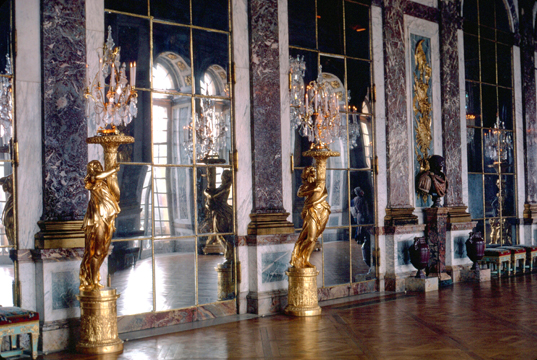 A Closer View of Some of the Mirrors |
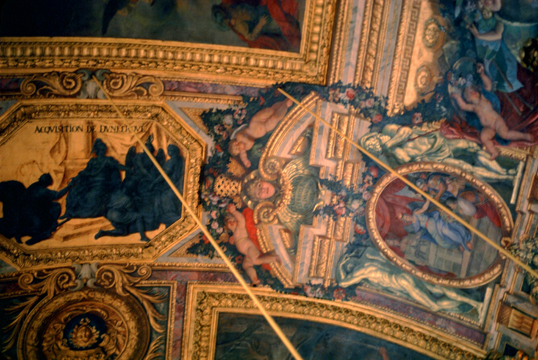 The Ceiling in the Hall of Mirrors |
In most of the rooms, the ceilings were as ornately-decorated as the walls or the furnishings, and almost every square foot of every ceiling was either painted, frescoed, or decorated with intricately-carved wood. Gold leaf was also extensively used. Of course, we think it is just great if a room has a white ceiling with nice crown molding; about the only painted ceilings these days are found in nurseries. Here are my last two interior views from the Palace at Versailles:
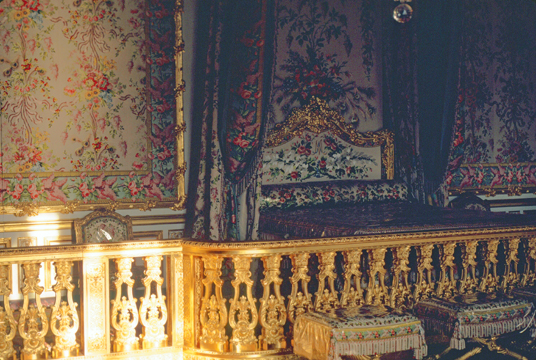 The King's Bedchamber |
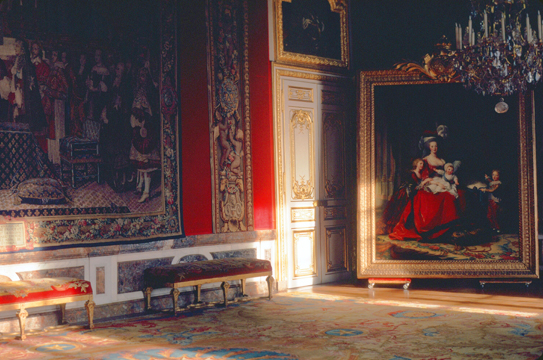 Reception Room in the "Grand Apartment" |
Finishing up my walk through some of the rooms at Versailles, I spent some time outside as well, walking around the buildings and going a short ways out into the gardens. In comparing my pictures to today's aerial view, I find that in the 35 years since my visit, much has changed; pools have been filled in, the shape of some of the gardens (particularly those near the palace) has changed, and so on. So instead of trying to show you where each view was (or is), I'll just include them here.
|
As part of an autonomous public entity operating under the aegis of the French Ministry of Culture, the gardens are now one of the most visited public sites in France, receiving more than six million visitors a year.
In addition to the meticulous manicured lawns, parterres of flowers, and sculptures are the fountains, which are located throughout the garden. Dating from the time of Louis XIV and still using much of the same network of hydraulics as was used during the Ancien Régime, the fountains contribute to making the gardens of Versailles unique. On weekends from late spring to early autumn, the administration of the museum sponsors "Les Grandes Eaux" ("Big Waters")– spectacles during which all the fountains in the gardens are in full play. Last year, the gardens (along with the château) were designated a UNESCO World Heritage site (one of thirty-one such designations in France).
|
|
|
|
As many tourists I am sure actually do, I could have spent all afternoon here at Versailles; as it was, I stayed here until about 3:30 and the November sun was going down behind the trees. This is a better spring or summer stop, I am told, simply because the gardens are in bloom then. So as the afternoon was fading, I went back to the entry gates and the Court of Honor.
|
|
|
|
My visit to Versailles was certainly worth the full day that it took to get out here, tour around the chateau and gardens and then get home again to my hotel. I'd recommend it to anyone, and indeed I would like to see what it looks like in springtime.
|
The trip back to downtown Paris on the train required a change at a suburban station so I got off the train temporarily to see what the Paris suburbs were like. I did find that, far outside the city, there was some housing that was somewhat comparable to our own suburban living, although the houses definitely had a French look to them. Even more interesting was the fact that, near the station, there was what looked like a shopping mall. It looked much like upscale malls here, except that there was not nearly so much parking space around it. I decided to go inside that see what it looked like.
I guess I expected to see a Gap and a Sears and a Waldenbooks, but all I saw were French and Canadian stores (I did see branches of some of the same stores that I have seen in Canada). I was, however, pleasantly surprised to run across this store, so I chalked up my second French Baskin-Robbins.
You can use the links below to either continue on with my side trip to Rheims or return to the main page for my visit to France so you can continue on through the photo album.
 |
My Trip to Rheims |
 |
Return to the Paris Trip Page |